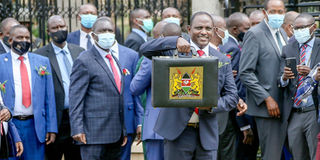Building back better: How Kenya plans to trigger higher, more inclusive, economic growth
Sponsored by The National Treasury

The National Treasury and Planning Cabinet Secretary, Mr Ukur Yatani, outside Parliament in Nairobi ahead of presenting the 2021-2022 budget for Kenya.
What you need to know:
Ksh23.1 billion: For Economic Recovery Strategy. |
Ksh302.1 billion: For enhanced security to promote stability, investment and growth. |
Ksh310.7 billion: For investing in infrastructure to unlock growth potential. |
Ksh202.9 billion: For enhancing access to quality education outcomes. |
Ksh93.2 billion: For environment management and protection, flood control and water harvesting. |
Ksh103.4 billion: Towards equity, poverty reduction and social protection for vulnerable groups. |
Ksh23.0 billion: For leveraging ICT. |
Ksh409.8 billion: Transfer to county governments |
By Evans Ongwae
Recovery and inclusivity. These words define the spirit of Kenya’s budget for the Financial Year 2021-2022, presented on June 10.
A quick analysis shows that in formulating the way forward in its spending, the Government first cast a glance back at the socio-economic challenges that the Covid-19 pandemic triggered in 2020.
Hence, the focus of the 2021-2022 budget is on promoting stability, resilience and growth. It is about recovery and then taking off to a higher trajectory, with all stops being pulled out to carry everyone along.
The Ksh3 trillion budget pushes expenditure in areas expected to grow an economy heavily battered last year due to Covid-10.
Building on the gains made from the Economic Stimulus Programme initiated to mitigate the adverse economic impacts of Covid-19 on the population, the Government is now set to implement an Economic Recovery Strategy to trigger an inclusive and sustainable growth. This is in line with the budget theme, “Building back better: Strategy for resilient and sustainable economic recovery and inclusive growth.”
To achieve this, the Government is prioritising policies that will stimulate the economy, safeguard livelihoods, jobs and businesses, and enable industrial recovery.
The Government projects that economic growth will improve significantly from the 0.6 percent recorded last year, to 6.6 percent in 2021. The projected figure is higher than the 5.4 percent growth attained in 2019.
What gives the Government the confidence to make such an ambitious prediction?
A budget summary by The National Treasury explains in part that the growth will be “supported by a stable macroeconomic environment, expected favourable weather and ongoing Covid-19 vaccinations that are meant to create herd immunity and allow resumption of full economic activities.”
The budget has given spending on the Big Four Agenda and the implementation of the Economic Recovery Strategy top priority as the drivers of economic growth.
The summary asserts that the realisation of priority programmes under the Big Four Agenda is a critical path to supporting sustainable economic recovery and progress. Subsequently, the Government has allocated Ksh142.1 billion to support their implementation through various ministries, departments and agencies.
The Big Four Agenda cover Manufacturing for Job Creation, Food and Nutrition Security, Universal Health Coverage (UHC), and Affordable and Decent Housing.
Of Ksh142.1 billion allocated to support these, Ksh20.5 billion will go towards enabling greater investments in manufacturing; Ksh60.0 billion toboost initiatives promoting food and nutrition security; Ksh47.7 billion to provide forUHC; and Ksh13.9 billion to support construction of more affordable, decent housing.
Additionally, the Government has identified and allocated funds for further infrastructure development; for building a conducive environment for investments; and for improving social services. These are in themselves enablers of the “Big Four” Agenda.
So is ICT. The Government has committed Ksh23.0 billion to support the sector. ICT has great potential to catalyse economic recovery, boost the attainment of the Big Four initiatives, and generally improve the lives of Kenyans.
Greater access to ICT is increasingly of interest, particularly in the wake of the Covid-19 pandemic, when minimal physical contact is encouraged.
On infrastructure, the Government remains keen on the construction of modern highways as well as urban and rural roads in every part of the country. This is to open up many more areas to economic activity, for wider inclusivity.
Railway transport continues to improve interconnectivity and reduced traffic congestion on roads, while the construction of ports stands to enhance job creation.
In infrastructure in general therefore, the Government has allocated Ksh310.7 billion for the FY 2021-2022.
The budget also recognises the need for more investments in human capital development. “The allocations in the FY 2021/22 include those aimed at enhancing learning and building competencies to develop quality and relevant skills for the 21st Century,” states the summary.
To enhance “access to quality education outcomes”, the Government has put aside some Ksh202.9 billion.
Other key allocations focus on improving environmental and water management, poverty reduction and social protection for vulnerable groups, energy, security, and support to county governments, and more.
For a simplified breakdown on specific budget provisions, a mwananchi guide to the FY 2021-2022 budget is downloadable from here.


